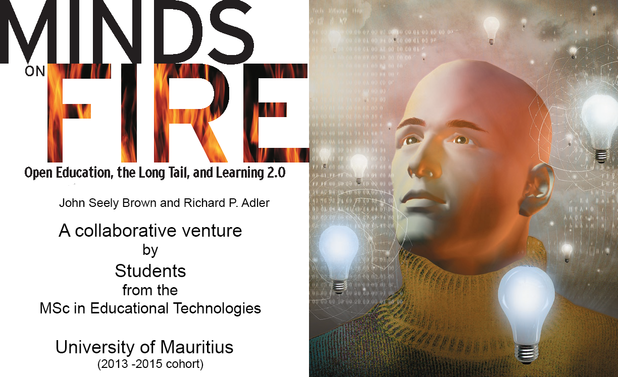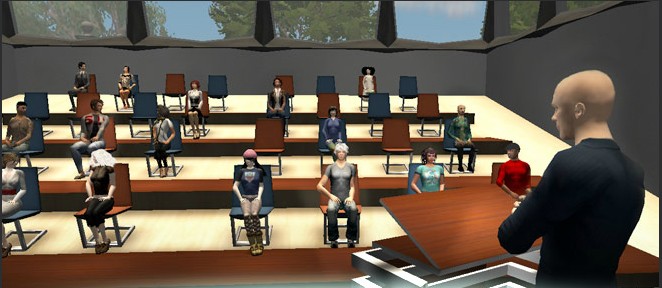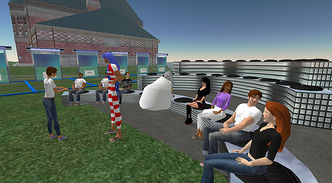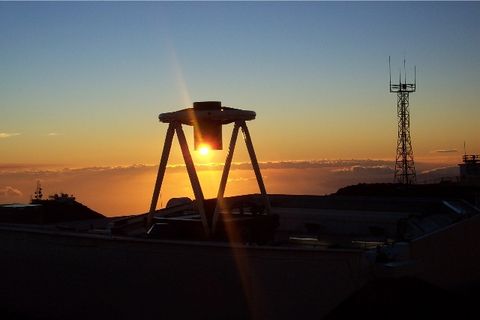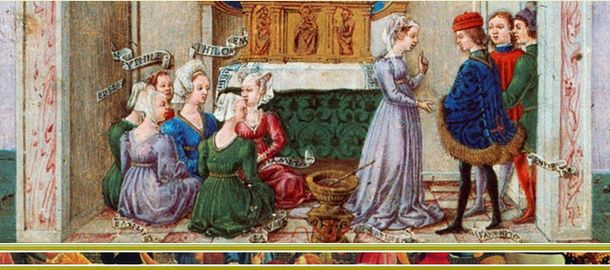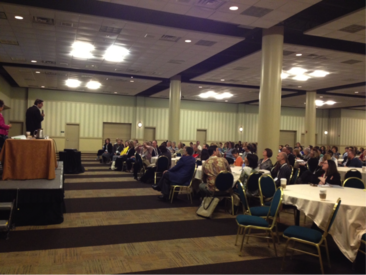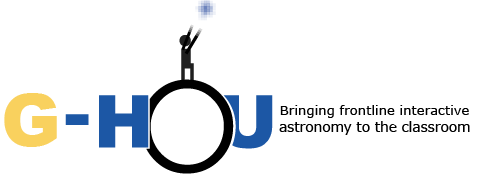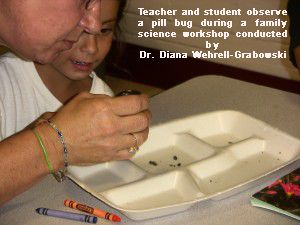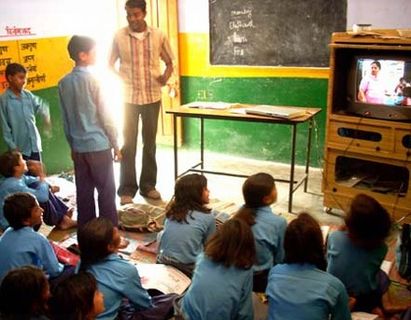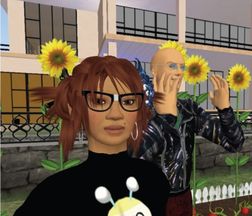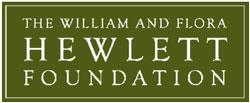Minds On Fire
Contents
- 1 List of Websites sited in the Minds on Fire Article
- 1.1 Terra Incognita
- 1.2 CyberOne classroom - Law in the court of public opinion
- 1.3
- 1.4 The Faulkes Telescope Project
- 1.5 The Decameron Web
- 1.6 Carnegie Commons
- 1.7 Hands-On Universe (HOU)
- 1.8 The Bugscope Project
- 1.9 The Creative Class Group
- 1.10 'The Exploratorium
- 1.11 Mediatedcultures
- 1.12 Wired
- 1.13 The Digital study Hall
- 1.14 The Foundation’s Gallery of Teaching and Learning
- 1.15 The Second Life
- 1.16 The World Is Spiky
- 1.17 Hewlett Foundation
- 1.18 Aspen Institute
List of Websites sited in the Minds on Fire Article
John Seely Brown
Profession: Researcher
Area Of Expertise: Organizational Studies
Interests: radical innovation (digital) culture, ubiquitous computing, autonomous computing and organizational learning
Nickname: JSB
Major position and roles:
• Independent co-chair of the Deloitte Center for Edge Innovation (present)
• Senior fellow, Annenberg Center for Communication at USC (present)
• Chief scientist of Xerox Corporation (1992 – April 2002)
• Director of the Xerox PARC research center (1990 – June 2000)
• Cofounder of the Institute for Research on Learning
• Board member of multiple companies, including Amazon, Corning, MacArthur Foundation and Polycom
• Advisory board member of several private companies, including Innovation Exchange and H5
• Former board member of In-Q-Tel
Terra Incognita
http://www.usq.edu.au/newsevents/events/onlinelearning.htm%7C
http://maps.secondlife.com/secondlife/Terra%20incognita/128/128/0/
It is a project which includes a virtual classroom. It is known as Second Life, meaning an nline virtual world connecting people all around. It consists of study groups and tutoring is done in lecture style teaching.
USQ's flexible learning agenda aims to establish a sustainable range of learning opportunities that incorporate technology enhanced learning for all students.
Terra Incognita, a research project developed by Lindy McKeown Orwin in 2007 in Second Life (SL) which is a multi-user virtual environment (MUVE)
• It was a three months project making room to explore “Action Learning Cycle” in the context of a specific immersive environment
• The project illustrate the impact of action learning in a 3-D online environments
• The virtual environment allows deep learning to occur by focussing on doing, experiencing and reflecting on the material and using virtual worlds as a place to bridge the knowing–doing gap.
CyberOne classroom - Law in the court of public opinion
http://blogs.law.harvard.edu/vvvv/files/2006/09/CyberOne_2006-09-21.png
CyberOne is a Harvard Law course being freely offered to internet users.
It is a virtual classroom which consists of three levels of participation by students and of people wanting to study. Social learning is enhanced within formal education. CyberOne represents convergence of the Berkman Center’s and the Extension School’s ongoing processes of pedagogical innovation and experimentation, with inquiry into openness, new technologies and related policy, learning and social media. The course is supported by a grant from the Provost's Fund for Innovation in Instructional Technology, and by the resources of the Harvard Law School and Harvard Extension School.
The Faulkes Telescope Project
The project is a part of the E-Science movement. Students collaborate with working scientists. It forms part of the 'Learning to be' aspect of social learning. The project provides free access to two high powered robotic telescope (in Hawaii and Australia). The telescopes can be used remotely to carry out scientific investigations. Multimedia resources are also available such as interactive animations, google sky and videos.
The Faulkes Telescope Project is an education partner of Las Cumbres Observatory Global Telescope Network (LCOGTN). Its aim is to provide free access to robotic telescopes and a fully supported education programme to encourage teachers and students to engage in research-based science education. Access to resources and those of partners is provided at no charge to teachers and students.
Before going online and booking time on the telescope, users must register for an account via FTP website. Then they can run their own 29 minute long real time observational session on one of the telescopes. These telescopes are the largest robotic telescopes in the world available for U.K schools to control in real time. The project was also the winner of the 2008 Sir Arthur Clarke Award in the category of Achievement in Education
The Faulkes Telescope Projects in cooperation with Hands-On Universe runs many student observing projects such as supernovae observations, asteroid observations, the Lifecycle of Stars project and Hickson Compact Group of Galaxies project. Details of these, and many more projects can be found on the Faulkes educational website.
The Faulkes Telescope Project educational website consists of a large number of resources aimed at helping to deliver subjects such as Physics, Maths and Technology in the classroom through the medium of Astronomy. By accessing the education section of the Faulkes Telescope Project website, users will find all the information they need to carry out a wide range of activities and projects, as well as information to help them make the best use of the telescopes in their network.
The Decameron Web
http://www.brown.edu/Departments/Italian_Studies/dweb/dweb.shtml
It is a hub of study of one important literary work, the Decameron. The website provides source materials, annotations, bibliographies, essays and audio/visual materials on the work. It consists of a community of students and scholars. The site provides content on the literary, historical and cultural context of the Decameron.
They fundamentally believe that the new electronic environment and its tools enable us to revive the humanistic spirit of communal and collaboratively "playful" learning of which the Decameron itself is the utmost expression. Through a creative use of technology, their project provides the reader with an easily accessible and flexible yet well-structured wealth of information on the literary, historical and cultural context of the Decameron, thus allowing a vivid yet rigorously philological understanding of the past in which the work was conceived.
The Decameron Web, developed by the Italian Studies Department at Brown University, is an impressive example of how the web can not only provide access to scholarly materials but also give students the opportunity to observe and emulate scholars at work.
The collection of materials on The Decameron Web will continue to grow in years to come, as students and scholars at Brown University and other institutions contribute syllabi, successful teaching strategies, new essays, interpretations, images, and so forth. A list of past and current contributors is already available. As contributions are received, the author's name and a list of works cited are added to the project simultaneously. We invite our readers to improve the quality of our site by sending us feedback and information.
Carnegie Commons
http://commons.carnegiefoundation.org
Founded by Andrew Carnegie in 1905, the Carnegie Foundation is an independent policy and research center. Its motivation has always been to improve teaching and learning. Its mission is to develop networks of ideas, individuals and institutions to advance teaching and learning. Carnegie commons is “A place to come together to exchange ideas about teaching and learning.” Carnegie Foundation explores new tools and processes for research and development leading to improvement in education. The Foundation is a community builder which believes that more can be accomplished together than alone.
The Carnegie Foundation is committed to developing networks of ideas, individuals, and institutions to advance teaching and learning. It joins together scholars, practitioners, and designers in new ways to solve problems of educational practice. Towards this end, they work to integrate the discipline of improvement science into education with the goal of accelerating the field’s capacity to learn to improve. One of the authors wrote one carnegie page- Laurie Spear:"_ there is more to college success than the Test scores and Lessons Plans" In fact Carnegie's focus is on "Productive Persistence"<br>
Carnegie Commons, a blog from the Carnegie Foundation for the Advancement of Teaching, includes news and information about the Foundation’s activities and interests in and approach to educational improvement in our nation’s schools and colleges. The opinions expressed in this blog are those of the authors. A place to come together to exchange ideas about teaching and learning. 4 main features are available to educators and learners for viewing posts. These are: “ What are we learning” , “ What are we reading” , “What is happening” , “What are we watching”.
Hands-On Universe (HOU)
Hands-On Universe (HOU) is an educational program that allows students to investigate the Universe while applying tools and concepts from science, math, and technology. It joins efforts from all around the world to train teachers on the use of modern tools and resources for science education and engage students in international scientific projects.
Features include:
1. Blog (Where users will find what’s latest at GHOU, news from our partners, stories from our collaborators around the world and conference updates)
2. An excellent set of software for teachers, educators and students around the world. These are field tested and user-friendly and free to be use for educational purposes.
The Hands-On Universe (HOU) project began in the 1990s when Carl Pennypacker, a supernova research astronomer at University of California Berkeley, invited a group of astronomers and educators to a meeting at the Lazy-K Ranch near Tucson Arizona USA. In sharing of ideas about how to make astronomy education better, the idea of making real telescopes and telescope images available to teachers and students took root. Along with that, image processing software tools became necessary to provide, as well as cooperation among astronomers and observatories to make telescope instruments available for use by schools.
Their aim is to promote interactive science projects among HOU countries and engage educators and students in a truly global cooperation. No borders or frontiers. Using the internet , HOU participants around the world request observations from an automated telescope ,download images from a large image archive and analyse them with the help of user-friendly image processing software.
Over the years, countries besides the USA became involved and Global Hands-On Universe (GHOU) Association was formed as a non-profit organization with partners worldwide.
The mission of HOU is to train teachers on the use of modern tools and resources for science education and engage students in international scientific projects. We also aim to promote interactive science projects among HOU countries and engage educators and students in a truly global cooperation. No borders or frontiers.
The Bugscope Project
http://bug scope.beckman.uiuc.edu
Bugscope is an educational outreach project that was created in 1999 and continues with support from the Beckman Institute at the University of Illinois at Urbana-Champaign.The Bugscope project provides free interactive access to a scanning electron microscope (SEM) so that students anywhere in the world can explore the microscopic world of insects. This educational outreach program from the Beckman Institute's Imaging Technology Group at the University of Illinois supports K-16 classrooms worldwide.
Bugscope allows teachers everywhere to provide students with the opportunity to become microscopists themselves—the kids propose experiments, explore insect specimens at high-magnification, and discuss what they see with our scientists—all from a regular web browser over a standard broadband internet connection.
Teachers give students the opportunity to do real science using state of the art technology. When submitting evaluations teachers emphasize the students' excitement and motivation and comment on the project's effective use of the internet.
How does it work?
Teachers sign up, ask their students to find some bugs, and mail them to us. The application made by the teacher is processed, proper session is scheduled, and the bugs are prepared for insertion into the electron microscope. When the session time arrives, the bug(s) are inserted into the microscope and set it up for the classroom. Then the teacher and the students login over the web and control the microscope.
The Creative Class Group
The Creative Class Group is a boutique advisory services firm composed of leading next-generation researchers, academics, and strategists. They believe that every single human being is creative—and only when we tap that great reservoir of overlooked and underutilized human potential can we truly achieve economic progress and a more meaningful, more fulfilling way of life. They empower communities, organizations and people to harness their innate creativity to achieve greater prosperity and well-being. The group is composed of scientists and engineers, university professors, poets and architects, and also includes people in design, education, arts, music and entertainment, whose economic function is to create new ideas, new technology and/or creative content.
'The Exploratorium
==
http://www.exploratorium.edu
The Explortorium is the global leader in informal education, igniting curiosity and inspiring creativity in people of all ages. Its first Exploratorium museum was opened to public in the fall of 1969. the founder of the museum was Frank Oppenheimer.Today the Exploratoriumworks with researchers around the world(from South Pole to NaSa)_This website has "over 50,000 pages of content, film screening, workshop for lifelong learners including science events for adults and professional development programs for educators. Since 1995, 6400 educators from 48 states and 11 countries have completed Exploratorium workshops. The museum which encourage school visits whereby experiences the novelty of latest technologies-Visitors are exposed to creative, thought-provoking exhibits, tools, programs and experiences to ignite curiosity, encourage exploration and lead to profound learning. Exploratorium has been planning lately 10 LIVING INNOVATION ZONES which are public places that will be used to strengthen community in San Francisco in USA.Their mission is to change the way the world learns, creating innovative learning environments, enthusiastic leaders, and new knowledge for teacher professional development.Users can Explore through Websites, Activities, Videos and Apps. http://www.exploratorium.edu/files/front/pinbell-posterframe.jpgThe videos consists of webcasts,podcast and slideshows on varied subjects among which Art, psychology or medicine.
http://bcove.me/6ur0yfhr
Education section include the following features:
1. For Educators : a) Professional Development Programs b) Tools for Teaching
2. For Learners : a) Community Programs b) Tools for Learning
3. For the Field : a) Learning About Learning
http://www.7x7.com/sites/all/files/imagecache/blog_large/exploratorium_liz.png
Mediatedcultures
Their work explores how humans use media, how media uses them, and how they can use new media to reveal their insights in new ways. It is video centered, putting students in various situations. Videos can be liked, watched later and shared under by the cc By- NC-SA License where users can remix, tweak and build upon with no commercial aspect, as long as mediated cultures are credited and that users license their creations under identical terms.
Wired
http://www.wired.com/wired/archive/12.10/tail.html
WIRED is the first word on how ideas and innovation are changing the world. Each month in the magazine and every day online, their editors deliver a glimpse into the future of business, culture, innovation, and science.
It consists of an online magazine to which one can subscribe to The subscription may defer users as it costs ten dollars one year Your are offered twelve issues for one year with articles from eminent personalities.<iframe width="560" height="390" src="http://player.cnevids.com/embed/527c2d484ffb602242000020/5176e89e68f9daff42000013" frameBorder="0" allowfullscreen webkitallowfullscreen mozallowfullscreen allowtransparency="true"></iframe>
The Digital study Hall
http://dsh.cs.washington.edu/info/overview.html
The Digital StudyHall (DSH) seeks to improve education for the poor children in slum and rural schools in India. It is video-centric, characterised by topics and chapters relating to curriculum. Database is build up by the contribution of the best teachers in rural schools, volunteers such as university professors, scientists, college students, and NGO staff members.
They digitally record live classes by the best grassroots teachers, transmit them on the "Postmanet" (effected by DVDs sent in the postal system), collect them in a large distributed database, and distribute them on DVDs to poor rural and slum schools. Education experts and teachers use the system to explore pedagogical approaches involving local teachers actively "mediating" the video lessons. By harvesting a "viral phenomenon" of community participation, DSH aims to help train teachers and deliver quality instruction to underprivileged children. The project is a collaboration between computer scientists and education experts.
Digital Study Hall has been operating in India since summer 2005 and its objective is to improve education for the poor children in slum and rural schools in India. In the Digital StudyHall project,a system that seeks to help kids and teachers from such schools is built.
To avoid retracing the missteps of earlier "wire-the-schools" projects, two important principles are being followed: (1) cost realism, essential if the system is to be scaled up to a significant number of schools and students; and (2) building systems that solve end-to-end education problems, so the twin pillars of technology and pedagogy must develop side by side, and content and people relationships must play leading roles.
DSH has developed over 2000 videos so far covering the state curriculum, special education, digital stories and teacher training videos. DSH content is not only used as a tool for quality education but also as a tool to motivate and empower. Furthering the agenda of gender equity and social awareness, DSH has recorded Critical Dialogues on topics like Domestic Violence, Sexual Abuse, Child Marriage and the problems faced by women in India. DSH has rapidly expanded beyond schools and beyond academic. In collaboration with the State Council of Education and Training (SCERT), DSH is running a capacity building project with 70 District Institutes of Education and Training (DIETs) in the state of UP, India. DSH videos have been widely appreciated and around 140 teacher educators and 1,40,000 teacher trainees are benefiting from this intervention. Beyond academic, The 'DSH Gender Empowerment' program is operating in 3 districts in Uttar Pradesh, covering 41 girls residential schools (KGBVs) and reaching out to around 3800 adolescent girls from undeserved communities.
The Foundation’s Gallery of Teaching and Learning
http://www.carnegiefoundation.org/resources/gallery-teaching
The Gallery of Teaching and Learning provides premier, digital representations of knowledge related to teaching and learning. The carefully crafted and vetted work of numerous participants of Carnegie Foundation programs and partners provides examples for individuals, projects, departments, institutions, communities of practice, and for the simply curious. Featured Resources & Exhibitions in the Gallery: 1)Every Child a Reader and Writer 2)Inside Teaching 3)CASTL-K-12 Gallery 4)CASTL Higher Education Collection 5)Integrative Learning Project 6)Windows on Learning: Resources for Basic Skills Education 7)Carnegie Initiative on the Doctorate (CID) Collection
The Second Life
http://secondlife.com/whatis/economy_stats.php
Enthusiasts stress that Second Life is not only another sort of gaming, but of living. The user acquires a screen persona (an‘avatar’) that can move fluently in and out of custom-designed environments for interaction and display. Concerts, meetings, relationships and educational practices can all be managed in such spaces. It is a great Social tool for Educators especially as it develops their capacity to immerse and motivate learners, and also the potential to alter a user’s relationship to technology. Some 3D Virtual game lovers might exploit its creative or social aspects, or use Second Life to teach specific content (geology or geography, for instance) through discussion, demonstration or practical exercises. While others (more particularly teachers and students) might see Second Life itself as a cultural or technical phenomenon deserving of study and also might simply regard the virtual world as a convenient location for a class meeting.
Benefits of Second Life in Education: - Hundreds of Learning Institutions are in Second Life Today - Engaging Learning Environment - Rich Inworld Learning Experiences Available Today - Collaborate with Other Learning Organizations - Reach More Students - Learn "Green"
The World Is Spiky
http://creativeclass.com/rfcgdb/articles/other-2005-The%20World%20is%20Spiky.pdf
With the advancement of technology, Globalisation can take place. Internet and Technological progress have steadily eroded the economic importance of geopgraphic place. Three types of places which may generate economic development are: First are the cities that encouraged innovation and which have ability to attract global talent and create new products. Second are those which support innovation Finally those places with little connection to global economy.
--- Growing Wikipedia Refines Its 'Anyone Can Edit' Policy
http://www.nytimes.com/2006/06/17/technology/17wiki.html
Wikipedia is the online encyclopedia that "anyone can edit. At its core, Wikipedia is not just a reference work but also an online community that has built itself a bureaucracy of sorts: one that, in response to well-publicized problems with some entries, has recently grown more elaborate.
Hewlett Foundation
http://www.hewlett.org/programs
- reduce poverty in developing world
- reduce carbon emissions
- improve education for students in California and elsewhere.
The Education Program makes grants to improve education by expanding the reach of openly available educational resources, improving California education policies, and by supporting"deeper learning" – a combination of the fundamental knowledge and practical basic skills all students will need to succeed.
The foundation have five programs
1. Education program( the interesting aspect is that part of the Educational program is the African Education InitiativeLink title which consists at funding "universal education,particularly in some of the most
resource-poor countries in the sub-Saharan Africa
2. Environment program
3. Global development and population
4. Performing Art program
5. Effective Philanthrophy group
Aspen Institute
The Aspen Institute is an educational and policy studies organisation based in Washington, DC.
Mission:
(1) foster leadership based on enduring values
(2) Provide a non partisan venue for dealing with critical issues
Four ways in which they operate are:
(1) Seminars
(2) Young Leader fellowshio around the globe
(3) Policy programs
(4) Public conference and events.
Current Principles • Continue to grow the leadership initiatives globally and expand public programs. • Provide opportunities for more horizontal integration across programs by linking public programs, leadership initiatives and policy programs. Environment, education, and health are the initial areas for cross- fertilization. • The Institute has increasingly become a venue for convening nonpartisan commissions to help resolve specific issues. The Institute will remain open to limited opportunities for convening such commissions where it can make a difference. • Incubate and facilitate action by individuals attending Institute programs. • Expand the domestic geographic footprint with a focus on programs in New York, Chicago and the San Francisco Bay area. The Institute’s general policy is that any seminar, leadership initiative, public forum, or policy program should support itself either through paid public participation, foundation funding, or other donations. These current principles provide a framework for going forward; however, opportunities for innovation and experimentation that do not fit within our mission will be undertaken periodically if there is the potential for a high impact on society.
